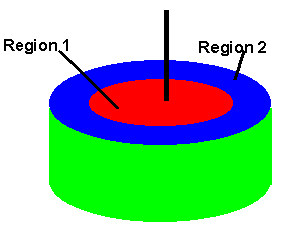Composite Model
Composite models are used when reservoir properties (e.g., permeability, net pay, and total porosity) and fluid properties (e.g., compressibility and viscosity) change at some distance from the wellbore. The figure below shows an example of a two-zone / region composite reservoir.

With the composite model, you can add any number of different cylindrical zones. With an unlimited number of zones, virtually any pressure transient response could be matched; therefore, it is important to exercise good judgement to determine when this model is appropriate. No reservoir is perfectly cylindrically concentric composite in nature; however, many reservoirs do behave the same way as composite reservoirs do. Some common situations where the composite model is useful include injection cases (which cause changes in viscosity and compressibility), reservoir heterogeneities (such as changes in flow capacity (kh)), and cases where the well was drilled into a naturally fractured reservoir with varying fracture distribution.
Note that the following assumptions apply when using this model:
- Both the inner and outer regions can be assumed to be homogeneous or dual porosity
- The wellbore has a finite volume and an infinitesimal skin
- There is no transition region between the inner and outer regions
References
1. "An Analytical Model for Composite Reservoirs Produced at Either Constant Bottomhole Pressure or Constant Rate", Olarewaju, J.S. and Lee, W.J., SPE 16763 (1987).
2. Issaka, B. (1996) Ph.D. thesis, University of Alberta, Canada.